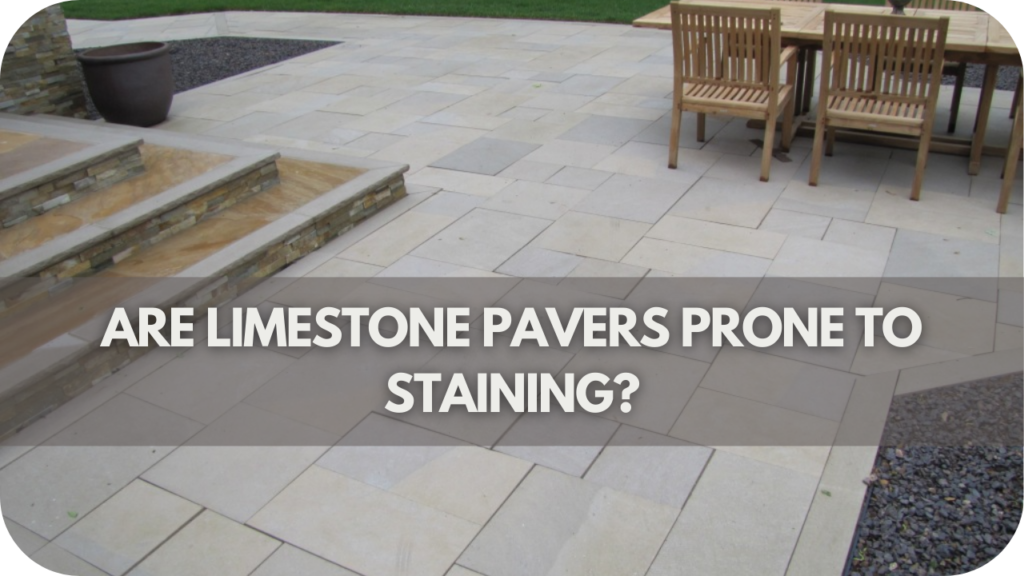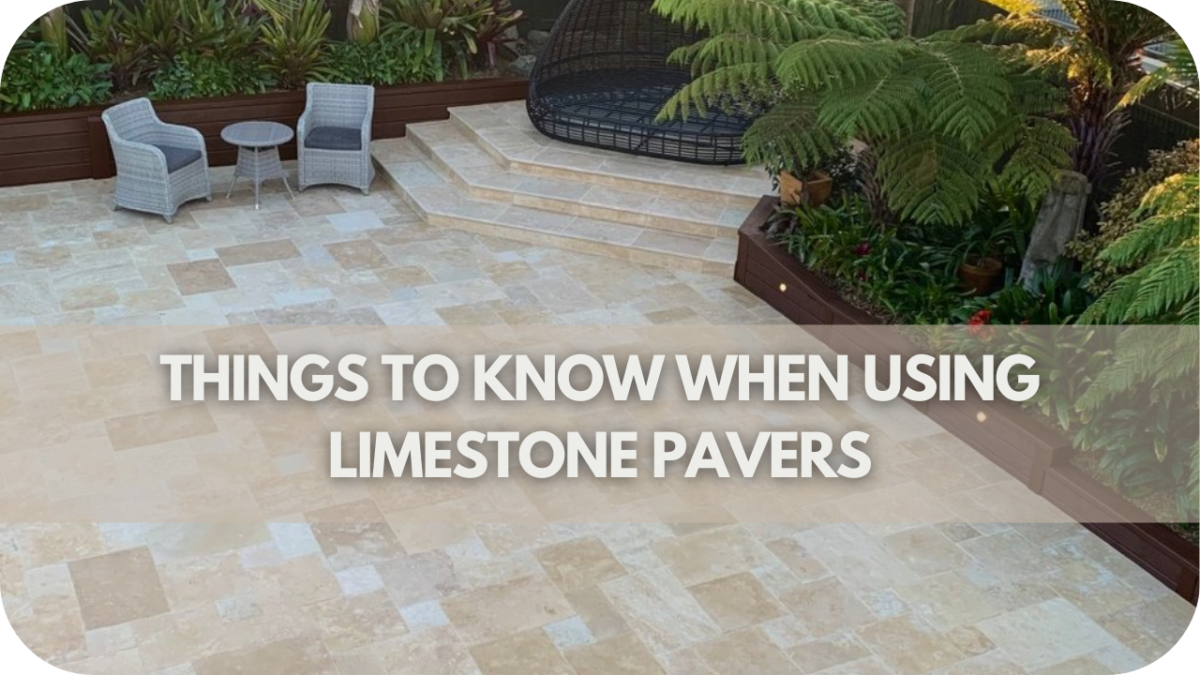Things to Know When Using Limestone Pavers
Struggling to choose the perfect paving material for your outdoor spaces?
With so many options available, it’s easy to feel overwhelmed and decide that might not suit your needs. Poor choices can lead to maintenance issues and lacklustre aesthetics.
Limestone pavers offer a durable, versatile, and visually appealing solution. This article will explore everything you need to know about using limestone pavers, from selection and installation to maintenance and care.
What Are Limestone Pavers?
Limestone pavers are natural stone tiles made from sedimentary rock. They are valued for their durability, versatility, and timeless appearance. Due to their slip-resistant surface and ability to withstand harsh weather conditions, they are commonly used for outdoor patios, pathways, and driveways. Limestone pavers come in various colours and finishes, adding elegance to any space.
Are Limestone Pavers Prone to Staining?

Limestone pavers can be prone to staining, especially when left untreated. Their porous nature makes them absorbent, allowing liquids like oil, wine, or water to seep in. Over time, these stains can be difficult to remove.
Does that mean limestone isn’t a good choice for pavers? Not necessarily. With proper sealing, the risk of staining can be significantly reduced. A high-quality sealant creates a protective barrier, making the surface less likely to absorb liquids.
However, if you don’t seal limestone, be prepared for frequent maintenance. Regular cleaning and quick action to wipe up spills are essential. Exposure to acidic substances, like lemon juice or vinegar, can also cause discolouration.
On the plus side, natural weathering can sometimes blend minor stains into the stone’s overall appearance. Still, it’s better to prevent staining altogether with sealants and care. Limestone can be a beautiful and durable choice, but only if you’re committed to maintaining its appearance.
Is Sealing Necessary for Limestone Pavers?
Sealing limestone pavers is highly recommended to protect their natural beauty. Limestone is a porous material that easily absorbs water, oils, and other liquids, leading to unsightly stains. Without sealing, everyday spills can quickly penetrate the surface, making maintenance more difficult.
But is sealing essential? For most homeowners, sealing limestone pavers offers long-term benefits. It helps prevent stains and reduces the risk of weather damage, as rain, sun, and temperature changes can wear down unsealed limestone faster.
A high-quality sealant creates a protective layer, making the pavers more resistant to spills and grime. Sealed limestone is easier to clean, requiring less effort to keep it looking fresh and new.
However, it’s important to note that sealing is not a one-time job. Regular reapplication is needed to maintain the protection. Still, this small investment in time and effort can extend the lifespan of your limestone pavers.
Ultimately, sealing helps preserve limestone’s appearance and durability, making it a wise choice for those looking to minimise future upkeep.
What Is the Cost of Limestone Pavers?
Limestone pavers are generally considered a mid-range option in terms of cost. Prices can vary depending on quality, thickness, and the region from which they are purchased. Typically, limestone pavers range from $70 to $235 per square metre.
Is limestone worth the price? For many homeowners, its natural elegance and durability justify the investment. While not the cheapest option, limestone offers excellent value for long-term use. Its timeless appearance and ability to withstand weathering make it a popular choice.
Installation costs also need to be considered. Professional installation may add to the total expense, but it ensures the pavers are laid correctly, reducing future maintenance costs. Some may opt for a DIY approach to save on labour, but this requires skill.
Are Limestone Pavers Suitable for Pool Surrounds?
Limestone pavers are an excellent choice for pool surrounds due to their natural beauty and durability. Their light, neutral tones create a calm and inviting atmosphere around the pool area. But are they practical for this high-traffic, wet space?
Yes, limestone offers many advantages for pool surrounds. Its naturally cool surface helps keep the area comfortable underfoot, even in the hottest weather. Additionally, limestone pavers provide slip resistance when sealed correctly, making them safer around water.
However, moisture absorption can be a concern with limestone. If left unsealed, water from the pool may seep into the pavers, leading to potential stains or damage over time. To avoid this, proper sealing and regular maintenance are essential.
Another benefit is limestone’s ability to withstand weathering, meaning it won’t crack or fade quickly in outdoor conditions.
What Is the Ideal Pattern for Limestone Pavers?
Choosing the ideal pattern for limestone pavers depends on the style and function of your outdoor space. The running bond or brick pattern is popular for a classic, timeless look. This simple yet elegant arrangement makes it ideal for modern and traditional settings.
Are you looking to add more visual interest? A herringbone pattern might be the answer. This pattern is perfect for high-traffic areas due to its interlocking design, offering extra strength and stability.
An irregular or random layout can create a rustic charm for those who prefer a more natural, relaxed feel. Mixing different sizes of limestone pavers adds texture and variation to the space, giving it a unique character.
Large-format pavers can also be laid in a grid pattern for a sleek, contemporary look. This style offers clean lines and simplicity and works well in minimalist or modern garden designs.
What Is the Best Application for Limestone Pavers?
Limestone pavers are incredibly versatile and can enhance a variety of outdoor spaces. Their natural beauty and durability make them ideal for patios. Limestone can easily complement your aesthetic, whether you’re aiming for a sleek, modern design or a more rustic look.
Can limestone pavers work for driveways? Absolutely. Thanks to their strength and weather resistance, limestone pavers easily handle heavy traffic. They can withstand the weight of vehicles and maintain their appearance over time, making them a practical option for driveways.
Limestone adds a timeless charm to garden pathways. Its smooth, natural texture is comfortable underfoot, making it an inviting choice for pedestrian walkways. With the right pattern, limestone can elevate the design of your garden paths and create a cohesive outdoor space.
Limestone’s classic appeal also benefits terraces and courtyards. Its ability to withstand varying weather conditions makes it an excellent choice for outdoor entertaining areas.
Do Limestone Pavers Get Hot?
Limestone pavers are known for staying relatively calm, even in hot weather. Unlike darker stone materials, limestone’s light colour reflects more sunlight, which helps prevent it from absorbing too much heat. This makes limestone a comfortable choice for areas where people walk barefoot, such as patios or garden paths.
Is it true that limestone stays cool under all conditions? Not entirely. In extremely high temperatures, limestone pavers can still warm up—but they won’t reach the scorching levels seen in darker stones like granite. The light, neutral tones of limestone work to minimise heat retention, mainly when used in well-shaded areas.
For those concerned about surface temperature, choosing lighter shades of limestone can further help keep the pavers cool. Proper sealing can also enhance limestone’s ability to resist heat absorption.
Limestone is one of the better options if you’re looking for a paving material that won’t get excessively hot in the sun. Its cooling properties make it ideal for outdoor spaces, providing comfort and aesthetic appeal.
Benefits of Limestone Pavers
Limestone pavers offer a range of benefits that make them a preferred choice for various outdoor applications. Here are the key advantages:
- Durability: Limestone pavers are highly durable and ideal for high-traffic areas like patios, driveways, and walkways. They resist cracking and chipping and can handle heavy weight, ensuring long-lasting use.
- Easy Maintenance: Simple upkeep, such as regular sweeping and occasional washing, keeps them pristine. They resist stains and weather damage and remain attractive without costly cleaning.
- Versatility: Available in various colours and finishes, limestone complements any design theme. Customizable shapes and sizes allow for intricate patterns that enhance outdoor aesthetics.
- Heat Resistance: Limestone stays cool underfoot, even in direct sunlight, making it perfect for summer use in poolside or patio areas.
- Natural Beauty: Limestone’s organic patterns and colour variations bring timeless elegance to landscapes, making it suitable for classic and contemporary designs.
- Environmentally Friendly: As a natural, recyclable material, limestone is eco-friendly and contributes to sustainable building practices.
- Cost-Effective: More affordable than other natural stones like marble, limestone balances beauty, durability, and budget-friendly pricing.
- Longevity: Limestone’s resistance to weathering ensures decades of structural and visual integrity, making it a long-term investment.
- Weather Resistance: Dense limestone resists water absorption and damage from freezing, thawing, and harsh weather, maintaining its durability and appearance in various climates.
Maintenance and Care
Proper maintenance and care are vital to keep your limestone pavers looking their best and extending their lifespan. Here’s what you need to know:
- Regular Cleaning: Limestone pavers should be swept regularly to remove dirt, leaves, and debris that can cause stains and abrasions. Use a mild detergent mixed with water and a soft brush or mop for a deeper clean. Avoid harsh chemicals or acidic cleaners, which can damage the stone’s surface.
- Stain Prevention: Promptly clean up spills, especially from acidic substances like vinegar, wine, or citrus juices, which can etch and discolour the stone. For tougher stains, use a specialised limestone cleaner or poultice to draw out the stain without harming the pavers.
- Re-Sealing: Re-seal your limestone pavers every 1-3 years, depending on the level of foot traffic and exposure to elements. Regular re-sealing helps maintain the protective barrier against stains and moisture, ensuring the pavers remain in good condition.
- Weed and Moss Control: Weeds and moss can grow in the joints between pavers, leading to an unsightly appearance and potential damage. Remove weeds manually and apply a weed inhibitor to prevent regrowth. For most, a gentle scrub with a mild bleach solution can help, but always rinse thoroughly and avoid letting bleach sit on the stone.
- Repairing Damage: Inspect your limestone pavers periodically for any signs of damage, such as cracks or chips. Small damages can be repaired with limestone patching material, but consider consulting a professional to assess and address the problem for more significant issues.
- Seasonal Care: Avoid using salt or chemical de-icers on limestone pavers in colder climates, as these can cause deterioration. Instead, use sand or a non-corrosive de-icing product. In warmer climates, provide shade or use UV-protective sealants to prevent discolouration from sun exposure.
Conclusion
Incorporating limestone pavers into your project adds elegance and durability. Consider material, installation, and maintenance costs for a successful outcome. Ready to transform your space with limestone pavers?
Contact Splendour In Stone Melbourne today for expert advice and high-quality materials tailored to your needs. Let’s create something beautiful together.




